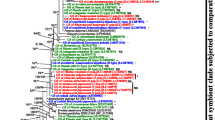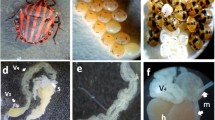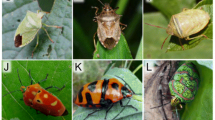Abstract
Insect bacterial symbionts are ubiquitous, however, only a few groups of host families have been well studied in relation to their associations with microbes. The determination of the phylogenetic relationships among bacteria associated with different species within an insect family can provide insights into the biology and evolution of these interactions. We studied the phylogenetic placement of vertically transmitted bacterial symbionts associated with the posterior midgut (crypt-bearing) region of pentatomid stink bugs (Hemiptera, Pentatomidae). Our results demonstrate that different host species carried one major bacterium in their midgut. Phylogenetic analyses of the 16S rRNA gene sequences obtained from the midgut of stink bugs placed all symbionts in a clade with Erwinia and Pantoea species, both plant-associated bacteria. Results indicate that symbiont monophyly occurs among recently diverged taxa (e.g., within a genus) but does not occur in the Pentatomidae. Results suggest that these vertically transmitted symbionts are occasionally replaced by other taxonomically similar bacteria over evolutionary time. Our findings highlight how the evolutionary history of hemipteran symbionts in unexplored host families may have unpredictable levels of complexity.

Similar content being viewed by others
References
Buchner P (1965) Endosymbiosis of animals with plant microorganisms. Interscience, New York
Baumann P (2005) Biology of bacteriocyte-associated endosymbionts of plant sap-suking insects. Annu Rev Microbiol 59:55–89
Fukatsu T, Hosokawa T (2002) Capsule-transmitted gut symbiotic bacterium of the Japanese common plataspid stinkbug, Megacopta punctatissima. Appl Environ Microbiol 68:389–396
Hosokawa T, Kikuchi Y, Nikoh N et al (2006) Strict host-symbiont cospeciation and reductive genome evolution in insect gut bacteria. PLoS Biology 4:1841–1851
Kikuchi Y, Hosokawa T, Fukatsu T (2007) Insect-microbe mutualism without vertical transmission: a stinkbug acquires a beneficial gut symbiont from the environment every generation. Appl Environ Microbiol 73:4308–4316
Kikuchi Y, Meng XY, Fukatsu T (2005) Gut symbiotic bacteria of the genus Burkholderia in the broad-headed bugs Riptortus clavatus and Leptocorisa chinensis (Hemiptera: Alydidae). Appl Environ Microbiol 71:4035–4043
Prado SS, Rubinoff D, Almeida RPP (2006) Vertical transmission of a pentatomid caeca-associated symbiont. Ann Entomol Soc Am 99:577–585
Abe Y, Mishiro K, Takanashi M (1995) Symbiont of brown-winged green bug, Plautia stali Scott. Jpn J Appl Entomol Zool 39:109–115
Lockwood JA, Story RN (1986) Adaptive functions of nymphal aggregation in the southern green stink bug, Nezara viridula (L.) (Hemiptera: Pentatomidae). Environ Entomol 15:739–749
Fukatsu T, Nikoh N (1998) Two intracellular symbiotic bacteria from the mulberry psyllid Anomoneura mori (Insecta, Homoptera). Appl Environ Microbiol 64:3599–3606
Cole JR, Chai B, Farris RJ et al (2005) The Ribosomal Database Project (RDP-II): sequences and tools for high-throughput rRNA analysis. Nucleic Acids Res 33:D294–D296
DeSantis TZ, Hugenholtz P, Keller K et al (2006) NAST: a multiple sequence alignment server for comparative analysis of 16S rRNA genes. Nucleic Acids Res 34:W394–W399
Huber T, Faulkner G, Hugenholtz P (2004) Bellerophon; a program to detect chimeric sequences in multiple sequence alignments. Bioinformatics 20:2317–2319
Swofford DL (2002) PAUP* Phylogenetic analysis using parsimony (*and other methods). Version 4. Version by D. L. Swofford. Sinauer, Sunderland, MA
Posada D, Crandall KA (1998) Modeltest: testing the model of DNA substitution. Bioinformatics 14:817–818
Ronquist F, Huelsenbeck P (2003) MrBayes 3: Bayesian phylogenetic inference under mixed models. Bioinformatics 19:1572–1574
Nylander JAA (2004) MrModeltest ver. 2. Program distributed by the author. Evolutionary Biology Centre. Uppsala University, Uppsala, Sweden
Hall TA (1999) BioEdit: a user-friendly biological sequence alignment editor and analysis program for Windows 95/98/NT. Nucleic Acids Symp 41:95–98
Stackebrandt E, Ebers J (2006) Taxonomic parameters revisited: tarnished gold standards. Microbiol Today 33:152–155
Acknowledgments
We thank Kent Daane and Jocelyn Millar (University of California, Berkeley and Riverside, respectively), William Haines and Jesse Eiban (University of Hawaii), and José Garcia (Universidade de Sao Paulo) for providing some of the insects used in this study. We thank and acknowledge Alexander Purcell, Daniel Rubinoff, and our laboratory colleagues for helpful discussions and comments on the manuscript. We thank David Rider for providing comments on the taxonomic status of the insect species used in this study.
Author information
Authors and Affiliations
Corresponding author
Rights and permissions
About this article
Cite this article
Prado, S.S., Almeida, R.P.P. Phylogenetic Placement of Pentatomid Stink Bug Gut Symbionts. Curr Microbiol 58, 64–69 (2009). https://doi.org/10.1007/s00284-008-9267-9
Received:
Revised:
Accepted:
Published:
Issue Date:
DOI: https://doi.org/10.1007/s00284-008-9267-9




